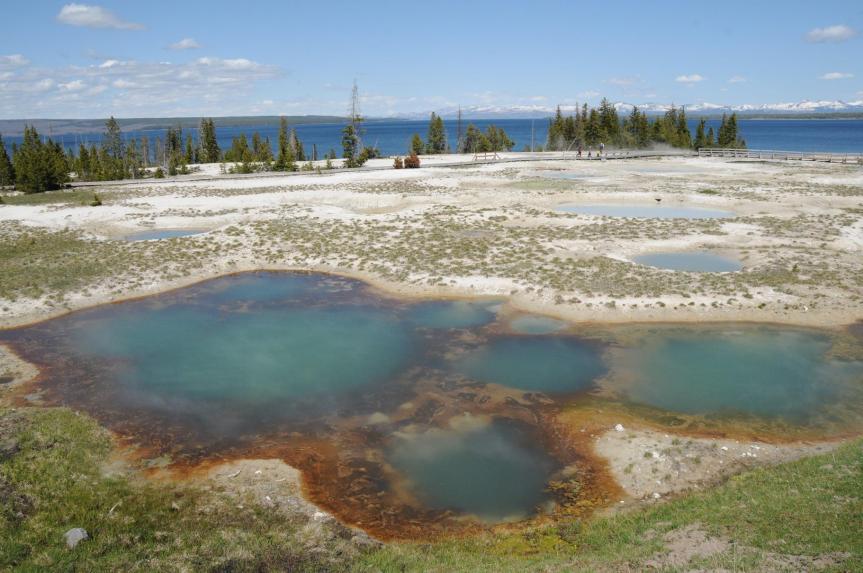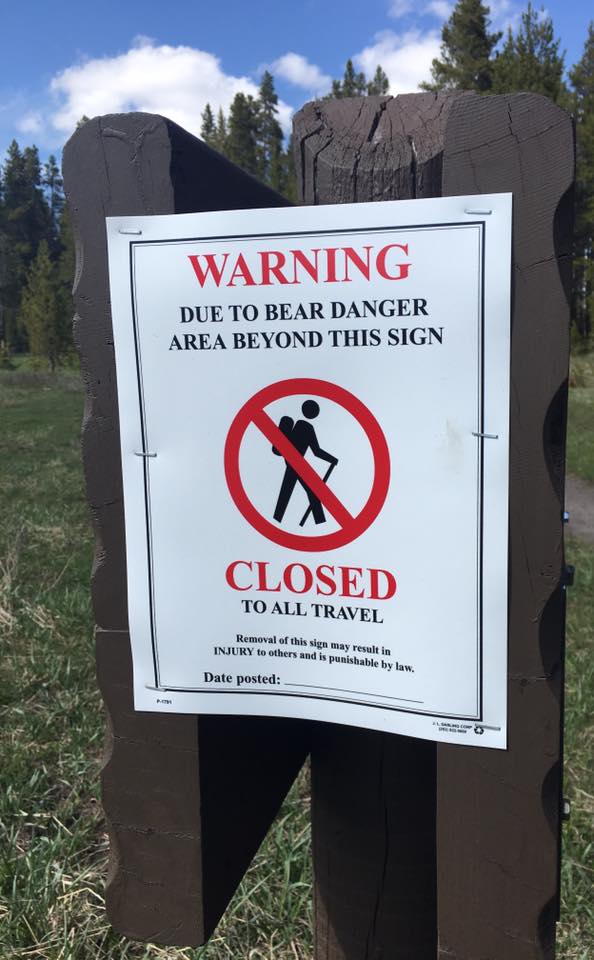Yellowstone Lake is the largest high elevation lake in North America.

The mountain range in the backdrop is the Absaroka Range – a sub-range of the Rocky Mountains – framing the eastern border of Yellowstone National Park. Named after the Absaroka Indians, the word Absaroka in Crow language means “children of the large-beaked bird”.

Yellowstone Lake has the largest population of wild cutthroat trout in North America.

West Thumb, at the southwest end of the lake, is about the same size as Crater Lake in Oregon and is a caldera within a caldera.
The hydrothermal features at West Thumb are found not only on lake shore

but also under the surface of the lake.

In the early 20th century, Fishing Cone was an active geyser erupting as high as 40 feet.

Nowadays the temperature cools down and Fishing Cone classifies as a hot spring. It is so named, because in early days, the anglers used to catch the trout from the lake, immediately dunk it into the cone and cook it on the hook.

That practice was banned in 1912.
Big Cone is also a cone geyser (think Old Faithful) that rises from the Yellowstone Lake 23 feet from the shoreline.

Black pool was cool enough up until 1991 for dark orange-brown bacteria to develop. When combined with the blue of the water, the pool appeared an exceptionally dark green to almost black. Hence the name.

In 1991, due to a shift in thermal energy, Black pool heated up, killing all bacteria and turning into a rich teal blue colored pool. The name remained nevertheless.

Boling at 181 °F (83 °C), Abysse Pool is one of the deeper hot springs in the park.

In 1871, F.V. Hayden commented that this spring’s “ultramarine hue of the transparent depth in the bright sunlight was the most dazzlingly beautiful sight I have ever beheld”.

After West Thumb Geyser Basin, we journeyed north, hugging the lake to our right, to Bridge Bay Marina. From there, we would take the easy one-mile walk to a rock formation called Natural Bridge.

Except that the trail was closed due to bear danger.
For those of us who’s not used to seeing bears in their natural habitat, this may sound like an open invitation. Isn’t bear sighting on everybody’s agenda in Yellowstone? I mean, some tourist even left a note complaining about the park not fulfilling their wishes – “Please train your bears to be where guests can see them. This was an expensive trip to not get to see bears.”
But this is not a joking matter. On July 6th, 2011, a couple from California was hiking the popular Wapiti Trail in Hayden Valley where they encountered a grizzly sow with her two cubs. The couple turned around and ran. The sow went after them, clawed and bit the man’s leg and left him bleeding to death. The woman feigned death, the sow picked her up by the backpack and dropped her onto the ground. She survived the attack. That mother bear was known as the Wapiti sow.
A month later, also in Hayden Valley, five miles up the Mary Mountain trail, another man hiking alone was attacked, but this time, the bear(s) consumed part of his body.
DNA evidence led to the same sow – whether she was the offender or was simply in the wrong place at the wrong time – she was trapped, sedated and euthanized. Her two cubs (Grant and Roosevelt) were sent to the Grizzly and Wolf Discovery Center in West Yellowstone and they would spend the rest of their lives behind bars.
When a bear takes a human’s life, it almost always pays with its own, sometimes more. Compared to Grant and Roosevelt, the cubs from the 2015 attack were not as lucky.
For your safety, here are some of the advices from the National Park Service:
- Heed the park’s warning signs for bear danger.
- Know what areas are closed for bear management.
- Learn how to reduce your risk of encountering a bear – Be alert. Do not hike alone. Don’t Hike at Dawn, Dusk, or at Night. Make loud noises. Avoid carcasses and stay with your stuff at all times.
- If you encounter a bear, don’t panic, slowly back away. Do not run, shout, or make sudden movements. Running may trigger a chase response in the bear and you cannot outrun a bear. Bears in Yellowstone chase down elk calves all the time. You do not want to look like a slow elk calf.
- If you are charged by a bear, stay still and stand your ground. Draw your bear spray from the holster, remove the safety tab, and prepare to use it if the bear is within 60 feet.
- If the bear makes contact, drop to the ground; keep your pack on to protect your back. Lie on your stomach, face down and clasp your hands over the back of your neck with your elbows protecting the sides of your face. Remain still and stay silent to convince the bear that you are not a threat to it or its cubs.
- After the bear leaves, wait several minutes before moving. Listen and look around cautiously before you get up to make certain the bear is no longer nearby. If the bear is gone, get up and walk (don’t run) out of the area.
- If a bear has not reacted aggressively, and has not initiated a charge or otherwise acted defensively, you should back away. Never drop to the ground and “play dead” with a bear that has not been aggressive or defensive.
Lastly, if you are curious what it looks like to be mauled by a grizzly bear, the movie “The Revenant” has a gruesome six-minute sequence of the experience. Bear in mind that according to a real life survivor, “Leo got off too lightly“.

The photos from the park are beautiful – I love the color of the water and of course the majestic geysers. Oh it’s so sad what happened to the hikers but it’s not really the bear’s fault is it.. I feel sorry for the poor cubs 😦 I enjoyed reading the tips to avoid bear attack. I was recently in Svalbard in Norway where they have many polar bears and a rifle is to be carried at all times (required by law) outside settlements in case of a bear attack. Polar bears are said to be ferocious and violent, maybe even more so than grizzlies.
LikeLiked by 1 person
Thanks Pooja. I myself were guilty of thinking polar bears were simply cute cuddly bears. Years ago when I was in Churchill Canada to see them, I even joked about petting one. How absolutely silly of me! I’ve never been to Svalbard, would like to someday 🙂
LikeLiked by 1 person
It’s their looks that are deceiving hehe! I hope you’ll make it to Svalbard one day.
LikeLiked by 1 person
Wow. This is a place we need to visit some day when we get on a road trip.
LikeLiked by 1 person
Thank you Mel & Suan!
LikeLiked by 1 person
Fantastic! What a beautiful place. And thanks for the bear info. Most of us don’t realize the danger.
LikeLiked by 1 person
Thanks Nico.
LikeLiked by 1 person
Yellowstone such a lovely area with such fantastic unbelievable features. Great photos and write up.
LikeLiked by 1 person
Thank you Terry!
LikeLiked by 1 person
Beautiful lake, and lovely captures of it from different angles. Hope you didn’t meet a bear along the way…even if you did, it could be friendly.
LikeLiked by 1 person
So wonderful 🙂
Mo-hugs
LikeLiked by 1 person
Fantastic post– a favorite park. Love your images and the story about dunking the fish in the caldera. I had read before about the tourists complaining…people are foolish to think National Parks are not wild places. Excellent info– thanks!
LikeLiked by 1 person
Great information on how to deal with a bear. I have duly noted this. There are reports occasionally that there have been bear sighted in the forest where I go on trail rides. But I have never seen one.
LikeLiked by 1 person
I’ve always wanted to take a drive around Yellowstone if I visit the States… The vastness of the landscape and the untamed wilderness is totally fascinating. Thank you for sharing! 🙂
LikeLiked by 1 person
beautiful place and nice pictures. thanks for sharing!
LikeLiked by 1 person
Beautiful photos and some very useful information about bears. It seems so sad that the mother bear paid with her life when she was simply protecting her young 😦 Also the note left by those tourist complaining about the lack of bear sightings is unbelievable – we’re not talking about cuddly teddy bears here! Great info thanks for sharing 🙂
LikeLiked by 1 person